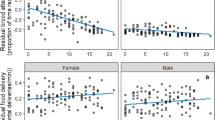Abstract
Brood sex ratio is often affected by parental or environmental quality, presumably in an adaptive manner that is the sex that confers higher fitness benefits to the mother is overproduced. So far, studies on the role of parental quality have focused on parental morphology and attractiveness. However, another aspect, the partner’s behavioral characteristics, may also be expected to play a role in brood sex ratio adjustment. To test this hypothesis, we investigated whether the proportion of sons in the brood is predicted by the level of territorial aggression displayed by the father, in the collared flycatcher (Ficedula albicollis). The proportion of sons in the brood was higher in early broods and increased with paternal tarsus length. When controlling for breeding date and body size, we found a higher proportion of sons in the brood of less aggressive fathers. Male nestlings are more sensitive to the rearing environment, and the behavior of courting males may often be used by females to assess their future parental activity. Therefore, adjusting brood sex ratio to the level of male aggression could be adaptive. Our results indicate that the behavior of the partner could indeed be a significant determinant in brood sex ratio adjustment, which should not be overlooked in future studies.


Similar content being viewed by others
References
Addison B, Kitaysky AS, Hipfner JM (2008) Sex allocation in a monomorphic seabird with a single-egg clutch: test of the environment, mate quality, and female condition hypotheses. Behav Ecol Sociobiol 63:135–141
Appleby BM, Petty SJ, Blakey JK, Rainey P, Macdonald DW (1997) Does variation of sex ratio enhance reproductive success of offspring in tawny owls (Strix aluco)? Proc R Soc Lond B 264:1111–1116
Bell AM, Hankison SJ, Laskowski KL (2009) The repeatability of behaviour: a meta-analysis. Anim Behav 77:771–783
Booksmythe I, Schwanz LE, Kokko H (2013) The complex interplay of sex allocation and sexual selection. Evolution 67:673–678
Both C, Dingemanse NJ, Drent PJ, Tinbergen JM (2005) Pairs of extreme avian personalities have highest reproductive success. J Anim Ecol 74:667–674
Bowers EK, Munclinger P, Bureš S, Kučerová L, Nádvorník P, Krist M (2013) Cross-fostering eggs reveals that female collared flycatchers adjust clutch sex ratios according to parental ability to invest in offspring. Mol Ecol 22:215–228
Cordero PJ, Griffith SC, Aparicio JM, Parkin DT (2000) Sexual dimorphism in house sparrow eggs. Behav Ecol Sociobiol 48:353–357
Cramp S, Perrins CM (1993) The birds of the Western Palearctic, VII. Flycatchers to shrikes. Oxford University Press, Oxford
Daan S, Dijkstra C, Weissing FJ (1996) An evolutionary explanation for seasonal trends in avian sex ratios. Behav Ecol 7:426–430
Dingemanse NJ, Both C, Drent PJ, Tinbergen JM (2004) Fitness consequences of avian personalities in a fluctuating environment. Proc R Soc Lond B 271:847–852
Dreiss A, Richard M, Moyen F, White J, Møller AP, Danchin E (2006) Sex ratio and male sexual characters in a population of blue tits, Parus caeruleus. Behav Ecol 17:13–19
Duckworth RA (2006) Behavioral correlations across breeding contexts provide a mechanism for a cost of aggression. Behav Ecol 17:1011–1019
Duckworth RA, Badyaev AV (2007) Coupling of dispersal and aggression facilitates the rapid range expansion of a passerine bird. Proc Natl Acad Sci U S A 104:15017–15022
Dunn JC, Cole EF, Quinn JL (2011) Personality and parasites: sex-dependent associations between avian malaria infection and multiple behavioural traits. Behav Ecol Sociobiol 65:1459–1471
Eising CM, Müller W, Groothuis TGG (2006) Avian mothers create different phenotypes by hormone deposition in their eggs. Biol Lett 2:20–22
Ellegren H, Gustafsson L, Sheldon BC (1996) Sex ratio adjustment in relation to paternal attractiveness in a wild bird population. Proc Natl Acad Sci U S A 93:11723–11728
Fidler AE, van Oers K, Drent PJ, Kuhn S, Mueller JC, Kempenaers B (2007) Drd4 gene polymorphisms are associated with personality variation in a passerine bird. Proc R Soc Lond B 274:1685–1691
Gammie SC, Garland T, Stevenson SA (2006) Artificial selection for increased maternal defense behavior in mice. Behav Genet 36:713–722
Garamszegi LZ, Eens M, Török J (2009) Behavioural syndromes and trappability in free-living collared flycatchers, Ficedula albicollis. Anim Behav 77:803–812
Garamszegi LZ, Rosivall B, Hegyi G, Szöllősi E, Török J, Eens M (2006) Determinants of male territorial behavior in a Hungarian collared flycatcher population: plumage traits of residents and challengers. Behav Ecol Sociobiol 60:663–671
Garamszegi LZ, Rosivall B, Rettenbacher S, Markó G, Zsebők S, Szöllősi E, Eens M, Potti J, Török J (2012) Corticosterone, avoidance of novelty, risk-taking and aggression in a wild bird: no evidence for pleiotropic effects. Ethology 118:621–635
Garamszegi LZ, Török J, Michl G, Møller AP (2004) Female survival, lifetime reproductive success and mating status in a passerine bird. Oecologia 138:48–56
Gomendio M, Clutton-Brock TH, Albon SD, Guinness FE, Simpson MJ (1990) Mammalian sex ratios and variation in costs of rearing sons and daughters. Nature 343:261–263
Gustafsson L (1988) Inter- and intraspecific competition for nest holes in a population of the collared flycatcher Ficedula albicollis. Ibis 130:11–16
Gustafsson L, Qvarnström A, Sheldon BC (1995) Trade-offs between life-history traits and a secondary sexual character in male collared flycatchers. Nature 375:311–313
Hegyi G, Garamszegi LZ, Eens M, Török J (2008) Female ornamentation and territorial conflicts in collared flycatchers (Ficedula albicollis). Naturwissenschaften 95:993–996
Hegyi G, Rosivall B, Szöllősi E, Eens M, Török J (2011) Context-dependent effects of nestling growth trajectories on recruitment probability in the collared flycatcher. Behav Ecol Sociobiol 8:1647–1658
Hegyi G, Szöllősi E, Jenni-Eiermann S, Török J, Eens M, Garamszegi LZ (2010) Nutritional correlates and mate acquisition role of multiple sexual traits in male collared flycatchers. Naturwissenschaften 97:567–576
Kempenaers B, Peres A, Foerster K (2008) Sources of individual variation in plasma testosterone levels. Phil Trans R Soc B 363:1711–1723
Ketterson ED, Nolan V, Wolf L, Ziegenfus C (1992) Testosterone and avian life histories: effects of experimentally elevated testosterone on behavior and correlates of fitness in the dark-eyed junco (Junco hyemalis). Am Nat 140:980–999
Kilner R (1998) Primary and secondary sex ratio manipulation by zebra finches. Anim Behav 56:155–164
Kiss D, Hegyi G, Török J, Rosivall B (2013) The relationship between maternal ornamentation and feeding rate is explained by intrinsic nestling quality. Behav Ecol Sociobiol 67:185–192
Kölliker M, Heeb P, Werner I, Mateman AC, Lessells CM, Richner H (1999) Offspring sex ratio is related to male body size in the great tit (Parus major). Behav Ecol 10:68–72
Martins TLF (2004) Sex-specific growth rates in zebra finch nestlings: a possible mechanism for sex ratio manipulation. Behav Ecol 15:174–180
Nager RG, Monaghan P, Griffiths R, Houston DC, Dawson R (1999) Experimental demonstration that offspring sex ratio varies with maternal condition. Proc Natl Acad Sci U S A 96:570–573
Naguib M, Todt D (1997) Effects of dyadic interactions on other conspecific receivers in nightingales. Anim Behav 54:1535–1543
Ophir AG, Galef BG (2003) Female Japanese quail that ‘eavesdrop’ on fighting males prefer losers to winners. Anim Behav 66:399–407
Otter K, McGregor PK, Terry AMR, Burford FRL, Peake TM, Dabelsteen T (1999) Do female great tits (Parus major) assess males by eavesdropping? A field study using interactive song playback. Proc R Soc Lond B 266:1305–1309
Peters A (2002) Testosterone and the trade-off between mating and paternal effort in extrapair-mating superb fairy-wrens. Anim Behav 64:103–112
Råberg L, Stjernman M, Nilsson JÅ (2005) Sex and environmental sensitivity in blue tit nestlings. Oecologia 145:496–503
Réale D, Reader SM, Sol D, McDougall PT, Dingemanse NJ (2007) Integrating animal temperament within ecology and evolution. Biol Rev 82:291–318
Rosenthal R (1994) Parametric measures of effects size. In: Cooper H, Hedges LV (eds) The handbook of research synthesis. Russell Sage Foundation, New York, pp 231–244
Rosivall B, Szöllősi E, Hasselquist D, Török J (2009) Effects of extra-pair paternity and sex on nestling growth and condition in the collared flycatcher, Ficedula albicollis. Anim Behav 77:611–617
Rosivall B, Szöllősi E, Hasselquist D, Török J (2010) Males are sensitive—sex-dependent effect of rearing conditions on nestling growth. Behav Ecol Sociobiol 10:1555–1562
Rosivall B, Török J, Hasselquist D, Bensch S (2004) Brood sex ratio manipulation in collared flycatchers (Ficedula albicollis): results differ between populations. Behav Ecol Sociobiol 56:346–351
Silverin B (1980) Effects of long-acting testosterone treatment on free-living pied flycatchers, Ficedula hypoleuca, during the breeding season. Anim Behav 28:906–912
Stoehr AM, Hill GE (2000) Testosterone and the allocation of reproductive effort in male house finches (Carpodacus mexicanus). Behav Ecol Sociobiol 48:407–411
Svensson L (1992) Identification guide to European passerines. British Trust for Ornithology, Stockholm
Török J, Hegyi G, Garamszegi LZ (2003) Depigmented wing patch size is a condition-dependent indicator of viability in male collared flycatchers. Behav Ecol 14:382–388
Trivers RL, Willard DE (1973) Natural selection of parental ability to vary the sex ratio of offspring. Science 179:90–92
van Oers K, de Jong G, van Noordwijk AJ, Kempenaers B, Drent PJ (2005) Contribution of genetics to the study of animal personalities: a review of case studies. Behaviour 142:1191–1212
van Oortmerssen GA, Bakker CM (1981) Artificial selection for short and long attack latencies in wild Mus musculus domesticus. Behav Genet 11:115–126
Whittingham LA, Dunn PO (2000) Offspring sex ratios in tree swallows: females in better condition produce more sons. Mol Ecol 9:1123–1129
Whittingham LA, Valkenaar SM, Poirier NE, Dunn PO (2002) Maternal condition and nestling sex ratio in house wrens. Auk 119:125–131
Wingfield JC, Ball GF, Dufty AM, Hegner RE, Ramenofsky M (1987) Testosterone and aggression in birds. Am Sci 75:602–608
Acknowledgments
We thank Rita Főző, Márton Herényi, Dorottya Kiss, Miklós Laczi, Gergely Nagy, and Sándor Zsebők for their help in the field and the lab and two anonymous referees for their valuable comments on the manuscript. We are also very grateful to the Pilis Park Forestry for its support.
Funding
The study was supported by grants from the Hungarian Scientific Research Found (grant no. F68295, PD75481, K75618, K101611), the Social Renewal Operational Programme of the Hungarian Government (TÁMOP 4.2.1./B-09/1-KMR-2010-0005 and 4.2.2./B-10/1-2010-0023), the Hungarian State PhD Scholarship to E. Szász, the Erdők a Közjóért Alapítvány, and the “Plan Nacional” program of the Spanish Government (ref. no. CGL2009-10652).
Author information
Authors and Affiliations
Corresponding author
Additional information
Communicated by: Pamela Rasmussen
Rights and permissions
About this article
Cite this article
Szász, E., Garamszegi, L.Z., Hegyi, G. et al. Aggressive behavior of the male parent predicts brood sex ratio in a songbird. Naturwissenschaften 101, 653–660 (2014). https://doi.org/10.1007/s00114-014-1204-0
Received:
Revised:
Accepted:
Published:
Issue Date:
DOI: https://doi.org/10.1007/s00114-014-1204-0




